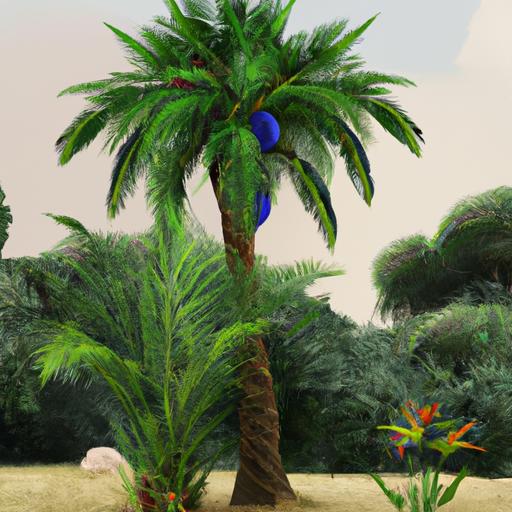Are you looking for an exotic and tropical touch to your outdoor living space, even in colder climates? Cold hardy palms are the answer! These hardy plants bring a lush, tropical feeling to any garden, and can even be grown in areas that experience freezing temperatures.
In this article, we’ll explore the top varieties of cold hardy palms, the benefits of having them in your garden, and how to care for them.
Read on to learn more!.
Table of Contents
Short Answer
Several species of palm trees are cold hardy and can survive in cold climates.
The most cold hardy species include the Windmill Palm, the Needle Palm, the Dwarf Palmetto, the Chinese Windmill Palm, and the Mediterranean Fan Palm.
These species can survive temperatures as low as -10F and require little to no protection in winter.
Benefits of Cold Hardy Palms
Palm trees are a great way to add a touch of the tropics to any outdoor space.
But if you live in a cold climate, you may be wondering which palms are able to withstand the cold temperatures.
Cold hardy palm trees are able to survive temperatures as low as 10F, and there are a variety of options available to suit different climates and locations.
Cold hardy palms offer a range of benefits, including: – Low Maintenance: Cold hardy palms require minimal maintenance and are able to thrive in full sun or partial shade.
– Versatility: There are a wide range of varieties of cold hardy palms to choose from, so you can find the right type for your space.
– Year-Round Beauty: Cold hardy palms can provide beautiful foliage and color throughout the year, even in colder climates.
– Increased Property Value: Adding a palm tree can instantly enhance the beauty of a home or business and can even increase the property value.
In addition to these benefits, cold hardy palms are also an excellent choice for areas where it’s not possible to plant a traditional tree.
These palms can provide a unique, tropical feel without taking up too much space, making them perfect for smaller yards and gardens.
Types of Cold Hardy Palms

When it comes to cold hardy palms, there are several varieties to choose from that can thrive in colder climates.
The Needle Palm is one of the most popular varieties due to its ability to survive in temperatures as low as 10F.
This type of palm has very fine, needle-like leaves and can grow in full sun or partial shade.
The European Fan Palm is another great option for colder climates, as it can withstand temperatures as low as -8F.
This palm has wide, fan-shaped leaves and is low maintenance.
The Mediterranean Fan Palm is also a great choice and can survive temperatures down to -8F.
This type of palm has a more upright growth habit and large, fan-shaped leaves, making it an attractive addition to any landscape.
Finally, the Windmill Palm is a great option for colder climates, as it can survive temperatures down to 10F.
This palm has a unique growth habit, with its leaves fanning out in a circular shape and its trunk growing in a spiral pattern.
All of these cold hardy palms can provide a beautiful, tropical look to any outdoor space, even in colder climates.
Needle Palm
The Needle Palm is a cold hardy variety of palm tree that is native to the southeastern United States, and it has the ability to survive temperatures as low as 10F.
This type of palm tree is a dwarf species and it typically reaches heights of about 10 feet.
It is known for its dense, needle-like leaves which are a deep green color.
The Needle Palm is a low maintenance tree and it can thrive in full sun or partial shade.
It is also resistant to many types of pests and diseases, making it a great choice for colder climates.
It prefers well-draining soil and it requires occasional watering to keep it healthy.
The Needle Palm is a great choice for those looking to add a tropical feel to their outdoor space while still being able to withstand the cold temperatures of the winter months.
European Fan Palm

The European Fan Palm (Chamaerops humilis) is a hardy, drought-tolerant palm tree that can survive temperatures as low as 10F.
This palm is native to the Mediterranean region, and is one of the few cold-hardy palms that can be grown in the United States.
The European Fan Palm is a slow-growing palm tree that can reach heights of up to 20 feet, with a spread of up to 10 feet.
It has fan-shaped fronds that are blue-green in color and can be up to three feet long.
The European Fan Palm is perfect for adding a tropical touch to gardens and landscapes in colder climates.
This palm tree is low-maintenance and can tolerate full sun or partial shade.
It is also highly drought-tolerant, and can survive if there is a lack of water.
The European Fan Palm can be grown in USDA Hardiness Zones 8-11.
Mediterranean Fan Palm
The Mediterranean Fan Palm (Chamaerops humilis) is a popular choice for gardeners looking for a cold-hardy palm tree.
This species is native to the Mediterranean region, hence its name, and is one of the most cold-tolerant palms available.
It can withstand temperatures as low as 10F and is a hardy choice for those who live in colder climates.
The Mediterranean Fan Palm is a slow-growing species that can reach up to 15 feet in height and has fan-shaped leaves that are up to 3 feet wide.
It is an evergreen species that is drought-tolerant and can thrive in full sun or partial shade.
This species also features a single trunk, which makes it ideal for planting in small spaces.
The Mediterranean Fan Palm is a low-maintenance species that requires minimal care.
It should be watered regularly and fertilizer can be applied in the spring and summer months.
This species is also resistant to pests and diseases, making it a great choice for those looking for a hassle-free palm tree.
Overall, the Mediterranean Fan Palm is a great choice for those looking for a cold-hardy palm tree.
Its low-maintenance requirements and ability to withstand cold temperatures make it an ideal choice for gardeners who live in colder climates.
Windmill Palm

The Windmill Palm (Trachycarpus fortunei) is a popular cold hardy palm tree that can tolerate temperatures as low as 10F.
Native to China and Japan, this palm is known for its fan-shaped leaves and ability to withstand cold.
It can also tolerate wind and salt, making it a great choice for coastal areas.
With moderate water needs and a slow growth rate, the Windmill Palm is easy to care for and can thrive in a variety of conditions.
It prefers full sun or partial shade and can reach a mature height of up to 25 feet, with a spread of 10 to 15 feet.
It is important to water newly planted Windmill Palms regularly until the root system is established.
The Windmill Palm is great for adding a tropical feel to any outdoor space.
Its distinctive fan-shaped leaves will add texture and visual interest to any landscape.
It can also be used as an accent tree or planted in groups to create a dense, tropical effect.
With minimal maintenance and a hardy nature, this palm is a great choice for cold climates.
How to Care for Cold Hardy Palms
Caring for cold hardy palms is relatively simple, but there are a few key things to keep in mind.
First, these trees need plenty of sunlight to thrive, so make sure to plant them in a spot that gets at least six hours of direct sunlight per day.
Additionally, they should be planted in well-draining soil that is slightly acidic, so you may need to add some organic matter or fertilizer to achieve the correct soil pH.
Lastly, cold hardy palms require regular watering, especially during the hot summer months.
Make sure to check the soil regularly to ensure that your palms are getting enough water.
If the soil is dry several inches down, its time to water your palms.
Additionally, you should prune your palms as needed to maintain their shape and keep them healthy.
Final Thoughts
If youre looking to add a touch of the tropics to your outdoor space, cold hardy palm trees are the perfect way to do it! With their minimal maintenance requirements and ability to survive temperatures as low as 10F, cold hardy palms can provide a beautiful, lush feel to any yard, regardless of the climate.
With the Needle Palm, European Fan Palm, Mediterranean Fan Palm, and Windmill Palm, there are plenty of options for cold hardy palms that can easily be incorporated into your landscape.
So why not give one of these varieties a try and enjoy a little bit of the tropics in your own backyard?.


